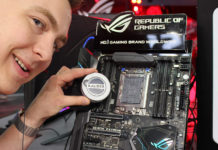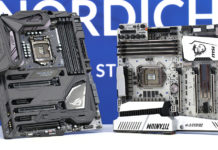ABIT looked back at its roots and then chose to develop the AW9D series for true overclocking enthusiasts. We’ve managed to get a hold of an engineering sample of AWD9-MAX and push the board to its limits as one should.
Intel has for the last 12 months released two different setups of motherboard circuits for the performance segment which have introduced certain complications for motherboard manufacturers. i955X was Intel’s first chipset with support for processors with dual cores, while the Pentium D processors of the 900 series which arrived at the end of last year required the updated chipset, i975X. To top it all off it turned out that these motherboards would not support Intel’s upcoming Core processors. They needed a minimal modifications of the voltage regulation, but alas an essential such. Abit, together with several other motherboard manufacturers, got stuck in between revisions and uncertainties up until a few months ago when the final chipset specifications arrived. These months of hard work has resulted in Abit’s new AW9D and the “MAX” version AW9D-MAX.

Today we have the honor as one of the absolute first hardware sites to seriously test Abit’s
coming AW9D-MAX motherboard. The sample we’ve received is one out of very few engineering samples and doesn’t come with all the features of the retail package. We’ve been informed that the differences are only cosmetic though, the function remains the same. Waiting for a full review of the board, with all of its accessories, we will start by investigating how this motherboard overclocks.
We start with a look at the specifications.
 | |
Abit AW9D-MAX – Specifications | |
| Processor support | Intel Socket 775: Core 2 Extreme, Core 2 Duo, Pentium Extreme Edition, Pentium D, Pentium 4, Celeron |
| Chipset | Intel i975X |
| Memory | 4x 240-pin DIMM Dual DDR2 400/533/667 channels Max. 8GB |
| Expansion slots | 2x PCI-Express x16 (2×8 SLI/Crossfire) 2x PCI-Express x1 1x PCI |
| Storage | 1x Floppy drive 1x Ultra DMA 133/100/66/33 IDE 8x SATA 3G (RAID 0/1/0+1/5/JBOD) (one external) |
| Internal connections | 6x USB 2x IEEE 1394 (Firewire) 1x COM port 1x AudioMAX 1x CD/AUX input |
| External connections | 1x PS/2 Keyboard 1x PS/2 Mouse 4x USB 2x RJ-45 (10/100/1000Mbit) 1x SATA |
| Size | 305 x 245mm |
| Other | Abit AudioMAX HD 7.1 expansion card Full uGuru support Blue diodes Power On and Reset buttons |
| Price | Not yet official |
We don’t know what will come along with the board in its retail suit, something we will return with when we know more. The features so far leaves little to wish for, everything you might want with an enthusiast board is there; dual GigaBit LAN, 8 channel HD sound circuit, 8 SATA ports and 10 USB ports.
Let’s take a look at the board itself.

Above we see the board that will go into massproduction and as you can see from the pictures below our board has red slots instead as it is an engineering sample.
A 24-pin ATX connector, an 8-pin EATX12V connector and a 4-pin Molex connector makes sure there is enough power. Equipping a board with these will most likely become standard as Intel’s coming Quad-core processors approaches, where Abit is the first company to bring official support for these with the AW9 series.
If we look at the cooling the board has been equipped with sturdy heatsinks together with a heatpipe system which transfers the heat away from the north and southbridge to a bigger heatsink seated higher up. Beneath this heatsink the board house power transistors for two of the four phases of the voltage regulation. Finally, the two remaining phase’s power transistors are cooled with their own heatsinks.
We take a closer look at the voltage regulation on the next page.
So, the power supply for the processor consists out of four phases. Each phase has four power transistors and one stabilizing coil. On top of this Abit has chosen to use so called “Solid State” capacitors all the way through. These are of a higher quality than normal electrolyte capacitors and doesn’t run the same risk of breaking down after a long period of use. On the last picture we see the power supply for the memory which also is very rigid. The processor voltage can be turned up to 1.7125V and the memory voltage all the way up to 2.65V, which should be more than what most memories of today need.
Power On and Reset buttons have appeared spontaneously on some models from Abit and they have now reappeared with this board. We are really fond of this function and hope they are here to stay. Further we have a picture of a 3-pin fan connector, but the interesting is not the connector itself , but the total number of these. A total of, including the 4-pin version for the processor fan, 8 connectors are available. In the true spirit of Abit, all of them can be controlled individually through software; ranging from 6V to 12V. On the back we find Abit’s “OC-stripes” which are for diverting the heat from the board and on the last picture we see one of the 8 blue diodes. With this board Abit has added the possibility to configure these according to a number of different light effects, or turn them off completely, through the BIOS.
Finally it is time to run the tests, but first we have to take a quick look at the test system.
 | |
Test system | |
| Hardware | |
| Motherboard | Abit AW9D-MAX ES, BIOS 12 |
| Processor | Intel Core 2 Extreme X6800 (Conroe, 0617) |
| Memory | Corsair XMS2 5400UL (D9 Fatbody) Corsair XMS2 8500 |
| Graphics card | nVidia GeForce 7900GT |
| Power supply | OCZ PowerStream 520W |
| Software | |
| Operating system | Windows XP (SP2) |
| Drivers | Intel Chipset Driver 8.1.1.1001 |
| Overclocking software | Abit uGuru |
| Benchmark program | SuperPi 1.1e Cinebench 9.5 WinRAR 3.60 |
We will be focusing on overclocking the motherboard, processor and memory. The processor was recently tested here, and the memories have been well tested throughout our earlier benchmarks. So let’s take a look at how the AW9D handles these.
We start by investigating how far we can push the FSB on this board.
For starters we tested the board at a specific frequency for a future reference. 3GHz is a speed most Core 2 processors can handle so we thought it would be a good idea to perform a series of tests at this speed.
Since we’ve been very pressured by the deadline we haven’t had the time to perform all of these tests with our reference system, but we will be back with more thorough comparisons soon.
Intel D975XBX: 266FSB, 11x, 2933MHz, 2:3 (800DDR)
At 3GHz you should be able to reach a SuperPi 1M result at right below 17s, without any advanced tweaks of the test system,
and that is precisely what we see here. We’ve mentioned in our previous articles that WinRAR displays an interesting load on the system’s memory and bus, and we can clearly see that you have a lot to gain from running a high FSB. Cinebench is more of a processor benchmark and the difference seen here is basically because of the higher frequency of the processor.
The highest FSB we could reach and run SuperPi 1M at was 473MHz, which required 1.95V to the northbridge. At 455FSb and 1.80V the boards was capable of running SuperPi: 32M, 3DMark06 and 3DMark05 without any problems.
Time to overclock the processor.
There was really no reason for us to hold back for the short period of time we have with the board. So, we prepared the board for some real cold; -100°C. Time for overclocking using a Cascade compressor setup.
It takes time to learn a new motherboard and this time we weren’t able to reach quite the same frequency as in our previous overclocking article. Thanks to the higher FSB the system still performs better despite a total 30MHz disadvantage.
Once again, Cinebench is considerably more dependent on the processor than WinRAR and therefore the diagrams can look a bit odd at a first glance.
We move on and conclude our experiences on the next page.
It’s hard to make any deeper conclusions from only two days of testing with such a versatile motherboard as this. We will take an even closer look at the board as soon as the retail version arrives, we still have a few thoughts and comments to share, on top of the overclocking potential.
BIOS and software
Abit spoils its users with its easy to use BIOSes. All the basic settings are the same as with other Abit cards and the main innovations are in the uGuru portion of the BIOS. uGuru and its functions are ofcourse a central part to comment when you are dealing with a board such as this one. uGuru is a, the least to say, an advanced fan controller. All of the 8 fan connectors can be individually controlled in reference to both temperatures and profiles. uGuru can be controlled through both BIOS and inside Windows, where you can also create profiles for different uses. It’s just the imagination that sets the limits for how you want to configure your fans.
Performance and stability
We will continue to test this board and its final version and put them next to other leading motherboard at equal circumstances. We experienced the performance as just as fast, if not even slightly faster, than Intel’s equivalent, BadAxe. We didn’t experience any stability problems or inconsequential behavior at all, but we will continue to test the board before we will be able to give you a final answer.
Overclocking
The BIOS let us set a wide variety of voltages for the processor, memory and northbridge. 1.7125V for the processor, 2.65V for the memory and 2.0V for the northbridge is enough to go really far, even during extreme circumstances. What we miss though is the ability to adjust the voltage for the system buss, Vfsb. On the memory front you can set all of the regular latencies, but with an enthusiast motherboard as this we we wouldn’t mind if there had been some more parameters for the latencies of the northbridge. These shortcomings are far from critical, and can be changed through software in Windows. The overclocking was a positive surprise to us. Without any hardware modifications we managed to reach a system bus of about 470FSB, something far from all i975X motherboards are capable of, and even fewer without modifications.
Conclusion
After sidetracking with the AW8 series, Abit seems to be on the right track again and it has clearly listened to the demands of the enthusiast market as we can see both high voltages, lots of space between the PCI-Express slots, start and reset buttons, etc. when designing AW9D-MAX. We’re really looking forward to seeing this board in the hands of more enthusiasts .
 | |
Abit AW9D-MAX | |
Pros Cons | |
We want to thank Abit for making it possible for us to review this motherboard.








































